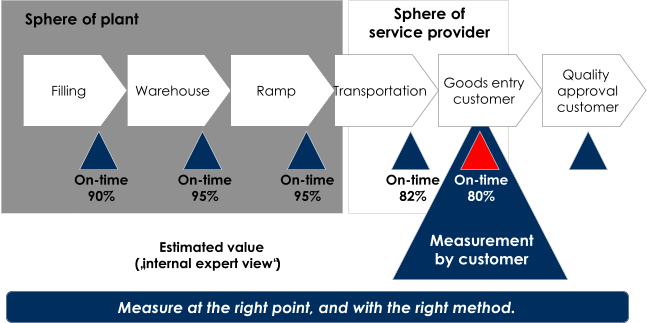

- Value Chain Excellence
- Company Business Performance
- Supply Chain Performance
- Supply Chain Strategy
- Integrated business management (S&OP)
- Digital Transformation
- Operational Improvement
- Transparency
- Complexity
- Agility
- Responsiveness
- Customer Needs
- Delivery Reliability
- SC Segmentation
- Inventory optimization
- Throughput Times
- Order Management
- Planning Excellence
- Cost management
- Logistics Cost
- Working Capital Optimization
- Supplier Optimization
- Transport Optimization
- Network Optimization
- Post Merger Integration
DELIVERY RELIABILITY
Delivery reliability needs the right
performance measurement to lead to the
right decisions, and improvement actions
•
When comparing on-time-delivery rates
between companies, there are often
confusions, irritations, and surprises.
Reason is that the metric reflects the way
of measurement of the real situation, not
the real situation itself. And there are
plenty of definitions of the delivery time
window, and how a delivery is measured
to be on time.
•
It should be all based on the
requirements of the customer who
receives the shipment. If he needs it in a
hourly time interval, that defines how to
measure. In other cases with more
tolerance, the actual day can count.
And sometimes it can be a few days
early, but not one day late. This is where
definitions vary, and thus the measured
value of the metric might also vary, or
indicate very different performance
levels.
•
Even today, we find that companies
measure on-time delivery based on their
factory shipment date, plus the average
transport time. But given today’s
congestions on motorways, delays of
trains, and even obstacles in air and
barch cargo, that is not sufficient to
draw the right conclusions, and to
implement the right corrective actions.
•
Part of the selection criteria for transport
service providers should be the
capability of online monitoring of the
shipment status, and also of goods
delivery. This is linked with internet or
cloud based solutions in which the
receiving customer confirms the receipt,
and also the inspection results (if
incoming goods inspection is still agreed,
and not assured by supplier shipment
processes).

Delivery reliability starts with the end in mind … and then looks
for the risks, and how to control them
•
Delivery reliability is a key prerequisite to operate a chain of
supply chains - only synchronizatinon based on
simultaneously adhered timings allows to run a proper
sequence. If one in the chain fails, the others fail. Either in
time, or in the need to build buffers which have the risk of
becoming obsolescent.
•
It is not only about being fast - but it seems, the faster the
chain gets, the more important is the reliablity. But this is a
wrong perspective, as the only thing that counts is the tact,
the “clock speed”. This is where the reliable delivery is key.
•
To manage the chain, observing own delivery reliability as
well as received from suppliers, is a core foundation to
operate the supply chain effectively, and efficiently.
•
Besides buliding IT-enabled process platforms which allow
fast, swift, nimble, and responsive delivery processes, the
risk associated with every single step need to be evaluated,
and according measures for risk mitigation need to be
developed, and - when necessary - quickly taken
•
With our IN-NOVA method on planning excellence, we
have build a systematic bridge between the sales, and the
supply markets. Please contact us if you want to learn more
about how you can use this for the benefit of your
operations.















